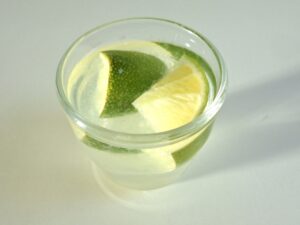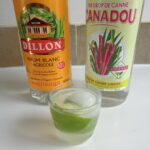
Ti punch
This cocktail from the French Antilles consists of rum, sugar and lime — but not just any rum, and not just any sugar. It’s name comes from a contraction of petit punch (‘little punch’) and, indeed, glasses are generally filled only halfway. And refilled often.
An authentic ti punch is made from rhum agricole, a clear rum distilled from sugar cane juice. It differs remarkably in flavor from other rums on the market, which can be distilled from molasses or even potatoes. While easy to find in France, rhum agricole can be harder to locate elsewhere. But a quick online check turned up sales sites in the United States and in Britain. Once you try it, you’ll never look back.
 The second key ingredient is raw cane sugar — demerara or cassonnade. You can either dissolve the sugar in the lime juice or go the easier route and use cane sugar syrup, which is available commercially or can be made at home (see below).
The second key ingredient is raw cane sugar — demerara or cassonnade. You can either dissolve the sugar in the lime juice or go the easier route and use cane sugar syrup, which is available commercially or can be made at home (see below).
As for the limes, count on one medium lime for four drinks.
And what about ice? In the tropics, where the drink arose, it’s traditional not to use ice. But frankly I think ti punch is best when chilled, so I either refrigerate the rum bottle ahead of time or add an ice cube to each glass.
Ti punch is said to have been invented on the Caribbean island of Marie-Galante, which is part of Guadeloupe, to celebrate the abolition of slavery in 1848. Whatever you may be celebrating, it’s a drink guaranteed to boost a festive ambiance.
For 1 drink:
1 tbsp. raw cane sugar or cane sugar syrup
1/4 lime
3 tbsp. rhum agricole (or more…)
Place the sugar or syrup in a small glass. Cut the lime quarter in half and squeeze one of the pieces into the glass.
Add the rum and stir. Add an ice cube if you like. Drop the remaining lime piece into the glass or fix on the edge for garnish.
Cane sugar syrup
1 cup raw cane sugar (demerara or cassonnade)
1 cup water
Combine the sugar and water in a saucepan. Heat until the sugar dissolves, then simmer for five minutes. Allow to cool.
Transfer the cooled syrup to an airtight jar or a clean empty wine bottle with a cork. Keeps virtually indefinitely. No need to refrigerate.




